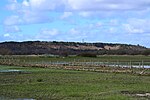1958 BOAC Bristol Britannia crash
1958 disasters in the United Kingdom1958 in England20th century in DorsetAccidents and incidents involving the Bristol BritanniaAirliner accidents and incidents caused by weather ... and 9 more
Airliner accidents and incidents in the United KingdomAirliner accidents and incidents involving controlled flight into terrainAirliner accidents and incidents involving fogAviation accidents and incidents in 1958Aviation accidents and incidents in EnglandBritish Overseas Airways Corporation accidents and incidentsDecember 1958 events in the United KingdomEngvarB from July 2014History of Dorset

G-AOVD was a Bristol Britannia 312 operated by BOAC which crashed near Christchurch, Dorset, in the south of England on Christmas Eve 1958, killing two of the five crew and all seven passengers.
Excerpt from the Wikipedia article 1958 BOAC Bristol Britannia crash (License: CC BY-SA 3.0, Authors, Images).1958 BOAC Bristol Britannia crash
Harpway Lane,
Geographical coordinates (GPS) Address Nearby Places Show on map
Geographical coordinates (GPS)
| Latitude | Longitude |
|---|---|
| N 50.767 ° | E -1.768 ° |
Address
Harpway Lane
Harpway Lane
BH23 7AN , Burton and Winkton
England, United Kingdom
Open on Google Maps







